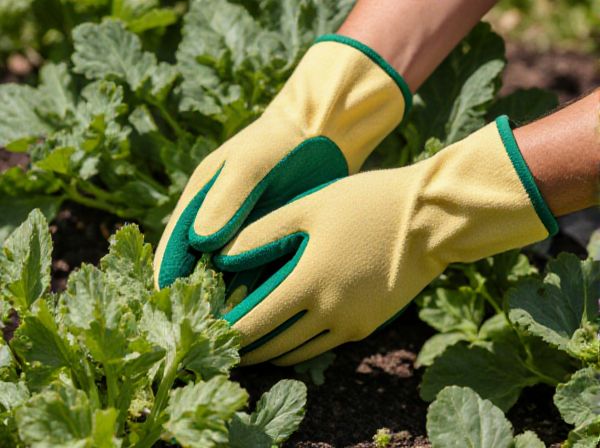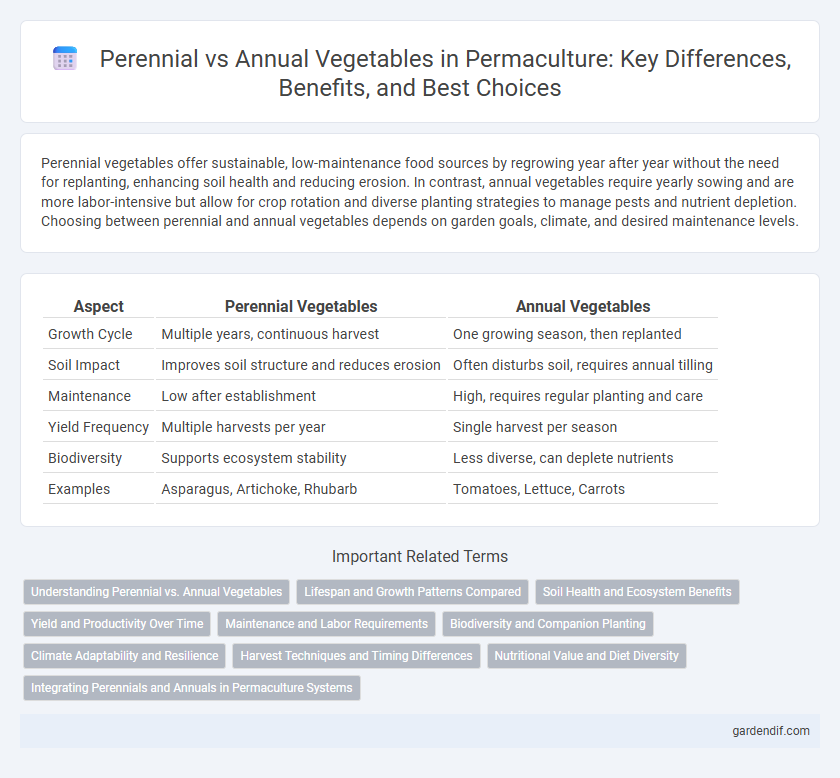
Perennial Vegetables vs Annual Vegetables Illustration
Perennial vegetables offer sustainable, low-maintenance food sources by regrowing year after year without the need for replanting, enhancing soil health and reducing erosion. In contrast, annual vegetables require yearly sowing and are more labor-intensive but allow for crop rotation and diverse planting strategies to manage pests and nutrient depletion. Choosing between perennial and annual vegetables depends on garden goals, climate, and desired maintenance levels.
Table of Comparison
| Aspect | Perennial Vegetables | Annual Vegetables |
|---|---|---|
| Growth Cycle | Multiple years, continuous harvest | One growing season, then replanted |
| Soil Impact | Improves soil structure and reduces erosion | Often disturbs soil, requires annual tilling |
| Maintenance | Low after establishment | High, requires regular planting and care |
| Yield Frequency | Multiple harvests per year | Single harvest per season |
| Biodiversity | Supports ecosystem stability | Less diverse, can deplete nutrients |
| Examples | Asparagus, Artichoke, Rhubarb | Tomatoes, Lettuce, Carrots |
Understanding Perennial vs. Annual Vegetables
Perennial vegetables grow and produce food for several years without needing to be replanted, offering sustainable soil health benefits and reduced labor compared to annual vegetables, which complete their life cycle in a single season and require yearly planting. Perennials like asparagus and artichokes develop deep root systems that improve soil structure and moisture retention, enhancing ecosystem resilience within permaculture gardens. Annuals such as lettuce and tomatoes provide rapid harvests and crop diversity but often demand more inputs, making perennials a strategic choice for long-term garden productivity and resource conservation.
Lifespan and Growth Patterns Compared
Perennial vegetables, such as asparagus and rhubarb, live for multiple years and continuously produce harvests once established, reducing the need for annual replanting and promoting soil health through stable root systems. Annual vegetables, like tomatoes and lettuce, complete their life cycle within a single growing season, requiring yearly sowing and often intensive soil disturbance. The longevity of perennials supports sustained yields and ecosystem resilience, while annuals offer quicker harvests but necessitate more frequent cultivation efforts.
Soil Health and Ecosystem Benefits
Perennial vegetables improve soil health by reducing erosion and promoting deeper root systems that enhance nutrient cycling and microbial diversity, unlike annual vegetables that require frequent tilling and replanting, which can degrade soil structure. These deep roots increase carbon sequestration and water retention, contributing to a more resilient ecosystem. Perennial systems also support greater biodiversity by providing habitat stability and continuous food sources for beneficial insects and soil organisms throughout the year.
Yield and Productivity Over Time
Perennial vegetables offer sustained yield and increased productivity over multiple growing seasons, reducing the need for annual replanting and soil disturbance. While annual vegetables provide a quick, often higher initial yield within a single season, their productivity requires consistent reseeding and labor input each year. Long-term permaculture systems benefit from the stability and soil health improvements of perennials, which balance yield fluctuations typical in annual crops.
Maintenance and Labor Requirements
Perennial vegetables require significantly less maintenance and labor compared to annual vegetables because they grow back year after year without the need for replanting. This reduces soil disturbance, watering frequency, and pest control efforts over time, leading to more sustainable and less labor-intensive gardening. Annual vegetables demand continuous planting, frequent care, and soil preparation each season, increasing the overall time and energy investment for gardeners.
Biodiversity and Companion Planting
Perennial vegetables enhance biodiversity by providing stable habitats and continuous food sources for beneficial insects and soil microbes, unlike annual vegetables that require yearly replanting and soil disturbance. Integrating perennial vegetables with companion planting techniques fosters synergistic relationships, improving pest control, nutrient cycling, and overall garden resilience. This combination supports sustainable ecosystem functions and promotes long-term agricultural productivity.
Climate Adaptability and Resilience
Perennial vegetables offer superior climate adaptability and resilience compared to annual vegetables due to their deep root systems, which enhance drought tolerance and nutrient uptake. Unlike annuals that require replanting each season, perennials maintain soil structure and microbial health, reducing erosion and improving long-term ecosystem stability. This resilience supports sustainable food production in variable climates, making perennial veggies a strategic choice for permaculture systems facing climate uncertainties.
Harvest Techniques and Timing Differences
Perennial vegetables require less frequent harvesting, often allowing continuous or staggered yields throughout their growing seasons, while annual vegetables need precise, timed harvesting periods since their growth cycle completes within one season. Harvest techniques for perennials emphasize selective picking of mature leaves or fruits to encourage ongoing growth, whereas annuals typically involve whole-plant or bulk harvesting after full maturation. The timing difference impacts labor and resource allocation, with perennials reducing annual planting efforts and providing extended harvest windows compared to annual crops' single, seasonal peak.
Nutritional Value and Diet Diversity
Perennial vegetables often provide higher nutrient density and a wider range of vitamins and minerals compared to annual vegetables, contributing to more balanced diets. Their ability to grow year after year without replanting supports consistent access to fresh, nutrient-rich greens. Incorporating both perennial and annual vegetables enhances diet diversity by offering varied textures, flavors, and phytonutrients throughout different growing seasons.
Integrating Perennials and Annuals in Permaculture Systems
Integrating perennial vegetables and annual vegetables in permaculture systems enhances soil stability, biodiversity, and year-round productivity by combining deep-rooted perennials with fast-growing annuals. Perennials like asparagus and kale provide continuous harvests while reducing soil disturbance, whereas annuals such as lettuce and beans offer rotational diversity and quick yields. This synergy optimizes nutrient cycling, pest management, and ecosystem resilience within sustainable food production frameworks.
Perennial Vegetables vs Annual Vegetables Infographic

 gardendif.com
gardendif.com